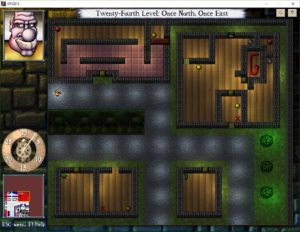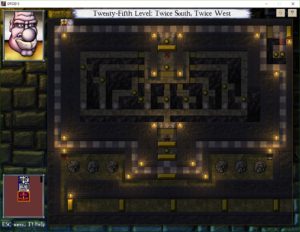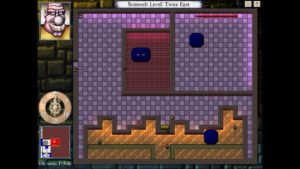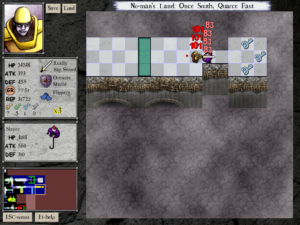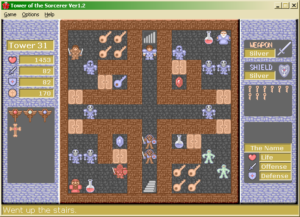JtRH: L7:1E
Time for a confession: Although my posts about DROD stalled last year, I didn’t really wait four months after finishing King Dugan’s Dungeon to start playing Journey to Rooted Hold. I started playing it from the beginning back in December, and got all the way to the end of the 7th floor without posting anything here about it. Then I got stuck. And now, having started from the beginning again, I’m stuck in exactly the same place.
“Stuck” isn’t really the right word. I can continue to the 8th floor any time I want. In fact, I have already done so, only to reload back into floor 7. What I’m stuck on is one of those Challenge scrolls. To date, I’ve been meeting every Challenge I find — as I noted before, this is the main part of the remakes that’s new to me, so it seems a shame to skip them. But this one Challenge has been a lot harder for me than any other I’ve seen.
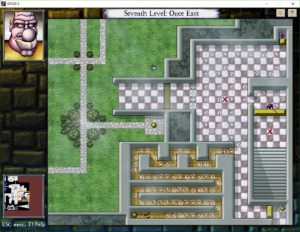 The overall theme of the seventh floor is puzzles involving invisibility potions and/or evil eyes — in particular, it makes puzzles out of the non-obvious fact that being invisible can be a liability, because monsters that can’t see you won’t chase you, and if they’re not chasing you, you can’t manipulate them into going where you want. The Slayer makes one appearance on this floor: after the repeated failure of his usual approach, he’s decided to just wait for you by the exit stairs. The stairs are near the floor’s start, but access to them is limited by an orb at the end of a long, winding hallway. If the Slayer follows you into that hallway, there’s no way to get back out. Thus, you need to be invisible, so he won’t follow you. There is an invisibility potion in the room, but you can only reach it if you enter via an alternate route in the south, which only opens after you conquer all of the other rooms in the level.
The overall theme of the seventh floor is puzzles involving invisibility potions and/or evil eyes — in particular, it makes puzzles out of the non-obvious fact that being invisible can be a liability, because monsters that can’t see you won’t chase you, and if they’re not chasing you, you can’t manipulate them into going where you want. The Slayer makes one appearance on this floor: after the repeated failure of his usual approach, he’s decided to just wait for you by the exit stairs. The stairs are near the floor’s start, but access to them is limited by an orb at the end of a long, winding hallway. If the Slayer follows you into that hallway, there’s no way to get back out. Thus, you need to be invisible, so he won’t follow you. There is an invisibility potion in the room, but you can only reach it if you enter via an alternate route in the south, which only opens after you conquer all of the other rooms in the level.
Or that was the intent, anyway. Someone figured out how to open the stairs without going through the alternate passage, so now it’s a Challenge. As the challenge scroll notes, you can skip the entire rest of the level this way.
Now, I can see only two possible routes to this goal. One is to kill the Slayer, but I don’t think this is likely. The room lacks features that can be exploited for this, and besides, would they really include both a Challenge for killing the Slayer in any room and another Challenge that requires killing the Slayer in a specific room? The other possibility is to take advantage of the Slayer’s Wisp. The Wisp is the thing that the Slayer uses to find a path to the player. It moves at one square per turn, leaving a trail of swirlies as it goes, and while it’s moving, the Slayer himself doesn’t move at all. So if you could lead the Wisp on a sufficiently long and winding path through the room, it would send the Slayer on a long and winding path while you escape from the long and winding hallway. I’ve managed to get within a hair’s breadth of making this work, but I assume that was the intent behind the room’s design: to make this approach almost but not quite workable.
I feel there must be some trick to making the winding path approach work. Some insight that I’m missing. And that’s largely why I’m still working on the problem. Most of the Challenges are of the form “Forget about the lynchpin, there’s an incredibly fiddly solution that you can do instead.” But this Challenge may well be introducing a lynchpin of its own.
 Comments(1)
Comments(1)